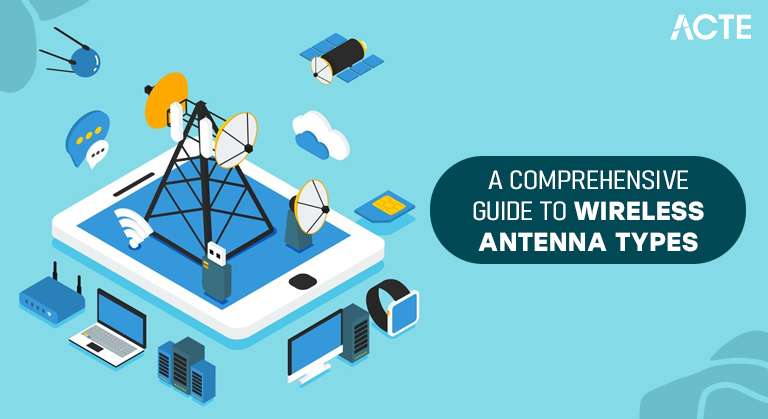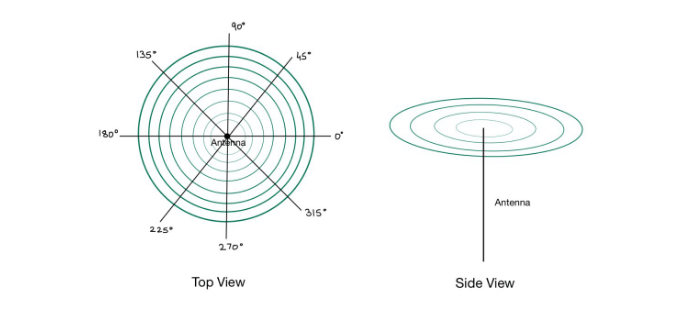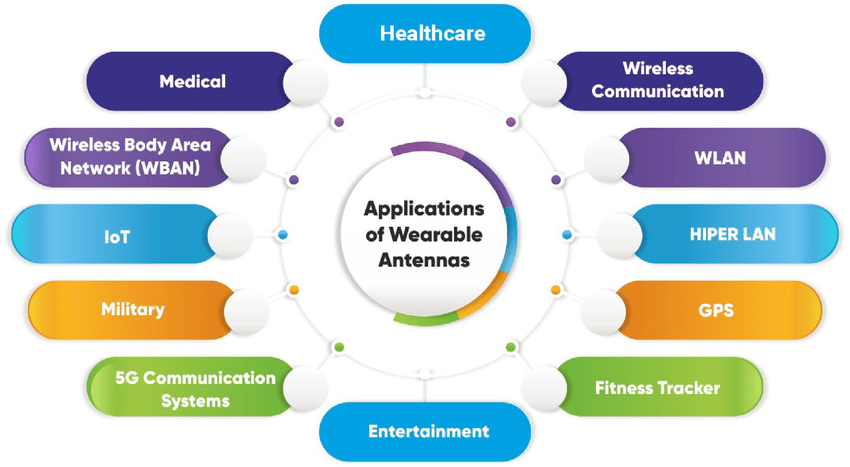
- Introduction to Wireless Antenna Types
- Antenna Fundamentals
- Wireless Antenna Types
- Specialized Antennas
- Antenna Design and Construction
- Applications of Wireless Antennas
- Installation and Maintenance
- Future Trends in Wireless Antennas
- Conclusion
enabling the transmission and reception of radio waves. There are various types of wireless antennas, each designed for specific applications and performance needs. These include omnidirectional antennas, which radiate signals in all directions, and directional antennas, which focus signals in a specific direction for improved range and signal strength, similar to how Cyber Security Training Courses help focus expertise in specific areas of network security. Other types, like parabolic, patch, and dipole antennas, offer unique benefits for various wireless technologies, from Wi-Fi to satellite communications. Understanding the different antenna types helps in optimizing signal coverage, data rates, and overall system performance.
Interested in Obtaining Your Wireless Antenna Certificate? View The Cyber Security Online Training Offered By ACTE Right Now!
Introduction to Wireless Antenna Types
Wireless antennas are necessary for communication systems as they enable the emission and reception of electromagnetic waves. There are two types mainly of antennas in the market: omnidirectional antennas emit a signal in all directions uniformly, with broad coverage, suitable for devices like Wi-Fi routers and mobile phones; on the other hand, directional antennas focus the signal in a specific direction to provide longer range and higher gain and are therefore utilized to the maximum in satellite and long-distance communication.

Popular forms include dipole antennas for general-purpose omnidirectional coverage, Yagi-Uda antennas for narrow directional coverage of TV and amateur radios, parabolic dish antennas for satellite systems, patch antennas for compact, directional coverage in GPS and Wi-Fi devices, and loop antennas used in RFID and low-frequency systems, much like how Network Access Control Lists are used to control and manage network traffic. The type of antenna chosen depends on the intended range, coverage area, and particular requirements for the application.
Antenna Fundamentals
Because they can transform electrical impulses into radio waves for transmission and vice versa for reception, antennas are crucial parts of wireless communication systems. A solid understanding of antenna principles is key to optimizing their performance for different uses. Below are the fundamental concepts of antenna technology:
- Function of Antennas: Antennas act as transducers, transforming electrical signals into radio waves during transmission and converting received radio waves back into electrical signals. This process involves generating electromagnetic fields that travel through space.
- Frequency and Wavelength: The performance of an antenna depends on the frequency and wavelength of the signals it handles. The wavelength (λ\lambdaλ) is the distance between two peaks of a radio wave, while frequency (F) refers to how often the wave oscillates per second. The relationship is expressed by the equation c=λ⋅fc = \lambda \cdot fc=λ⋅f, where ccc is the speed of light.
- Beamwidth: Beamwidth refers to the angle at which the antenna’s signal is concentrated, similar to how the Internet of Things devices rely on efficient signal distribution for communication across networks. A wider beamwidth suggests an omnidirectional or less focused antenna, whereas a smaller beamwidth indicates a more directed antenna.
- Polarization: Polarization refers to the orientation of the electric field in the radio waves emitted by an antenna. Types of polarization include linear (horizontal or vertical) and circular, which affect the alignment of antennas for effective communication.
- Impedance Matching: Proper impedance matching between the antenna and transmission line ensures efficient power transfer. Most antennas have a typical impedance of 50 ohms, and mismatches can cause signal reflection, power loss, and degraded performance.
To Explore Wireless Antenna in Depth, Check Out Our Comprehensive Cyber Security Online Training To Gain Insights From Our Experts!
Wireless Antenna Types
- Omnidirectional Antennas: These antennas radiate signals evenly in all directions, providing 360-degree coverage. They are common in Wi-Fi and mobile devices.
- Directional Antennas: Focus signals in a specific direction, increasing range and signal strength. Examples include Yagi and parabolic antennas.
- Dipole Antennas: Simple antennas with two equal-length conductors, often used in basic radio and TV systems.
- Monopole Antennas: A single-element variant of the dipole antenna, commonly found in mobile phones and base stations.
- Parabolic (Dish) Antennas: These antennas use a parabolic reflector to focus signals in a narrow beam, and they are commonly found in satellite communication and radar, similar to how Cyber Security Training Courses help focus expertise on protecting sensitive data and systems.
- Patch Antennas: Are flat, compact antennas usually installed in most equipment, such as GPS and mobile communication systems.
- Log-Periodic Antennas: Directional antennas with a wide frequency range are used in radio and TV broadcasting.
- Helical Antennas: Spiral-shaped antennas with both directional and omnidirectional functions, used in satellite communication.
- Array Antennas: These performance-enhanced antennas are multiple antennas for use in radar and communication systems.
Specialized Antennas
Specialized antennas are designed to fulfil specific needs in various communication systems, optimizing signal reception and transmission for particular applications. These antennas are designed with special characteristics such as directionality, size, or frequency range to enhance performance in tasks like long-range communication, satellite systems, or mobile devices. Examples include directional antennas that concentrate signals in one direction for a longer range and omnidirectional antennas that provide uniform coverage in all directions. Parabolic antennas are used in most applications involving satellite communications, as the dish shape is useful in collecting a lot of signal strength. Microstrip antennas are compact and are applied in the integration system, for example, in mobile handsets or GPS systems. Such specialized antennas play a crucial role in the efficient use of all communication platforms and environments.
Antenna Design and Construction
Frequency Range
The antenna is so designed that it should work efficiently within a given range of frequencies. The length, shape, and similar design parameters are determined according to the wavelength of the signal being transmitted or received through the antenna. A half-wave dipole, for example, is often a half-wavelength of the operating frequency.
Impedance Matching
The maximum transfer of power requires proper impedance matching between the antenna and the transmission line, which may be a coaxial cable, for instance. Impedance mismatch leads to signal loss and inefficient operation. Antennas are mostly designed to match the typical impedance of most transmission lines, which is 50 or 75 ohms.
Antenna Type and Shape
The shape and type of antenna depend on the desired coverage and directivity. Omnidirectional antennas are usually vertically polarized and offer 360-degree coverage, whereas directional antennas, such as a Yagi-Uda or parabolic dish antenna, concentrate the energy in one direction to increase the range and gain, much like understanding Why is Cybersecurity Important for protecting focused and valuable assets in a network.
Material Selection
The materials used in antenna construction should have good conductivity (e.g., copper, aluminium) to ensure a minimal signal loss. The choice of material also impacts durability, especially in outdoor environments where antennas may be exposed to weather conditions.
Size and Form Factor
The size of the antenna is determined by the operating frequency, and higher frequencies typically require smaller antennas. Compact antennas are commonly used in portable or mobile applications, whereas larger antennas are often utilized in longer-range communication applications, such as satellite links or broadcast towers.
Gain and Directivity
Antenna gain is the ability of the antenna to collect energy in a certain direction. Directional antennas have a high gain and are thus used in long-range communication, while omnidirectional antennas have low gain but guarantee 360-degree coverage.
Polarization
The polarization of an antenna denotes the way that the electric wave’s field is oriented. Types of polarization are vertical, horizontal, and circular, among others. The polarization should be the same as that of the transmitting antenna for good reception of a signal.
Testing and Tuning
Once the antenna structure is completed, its performance must be tested to confirm that it is indeed acting like the expected design. These include impedance, radiation pattern, and efficiency. Then, those parameters that need to be adjusted can be fine-tuned.
Are You Considering Pursuing a Master’s Degree in Cybersecurity? Enroll in the Cyber Security Expert Masters Program Training Course Today!
Applications of Wireless Antennas
Antennas are essential components in wireless communication systems, acting as transducers that convert electrical signals into radio waves during transmission and vice versa during reception. They generate electromagnetic fields that travel through space, facilitating the transmission and reception of information. The performance of an antenna is influenced by factors such as frequency and wavelength, much like how Network Topology affects the efficiency and performance of a network’s communication and data flow. The wavelength (λ) represents the distance between two peaks of a radio wave, while frequency (F) refers to how often the wave oscillates per second. The relationship between frequency, wavelength, and the speed of light (c) is expressed by the equation c = λ ⋅ F.

Key concepts in antenna technology include antenna gain, beamwidth, polarization, impedance matching, radiation patterns, and bandwidth. Antenna gain measures the concentration of energy in a particular direction, with high-gain antennas focusing energy to extend range. Beamwidth refers to the angle of signal concentration, where smaller beamwidths indicate highly directional antennas. Polarization determines the orientation of the electric field in radio waves, which affects antenna alignment. Impedance matching ensures efficient power transfer, while radiation patterns show how energy is distributed in space. Bandwidth represents the frequency range over which an antenna can operate without significant performance loss, and a wider bandwidth allows for greater flexibility in communication.
Installation and Maintenance
Installation
- Location: A location with few obstructions for maximum signal coverage.
- Mounting: Suits an antenna mount on a stable structure, maintaining the appropriate height and angle
- Cabling: Uses quality cabling and connectors, properly routing all of them to avoid damage.
- Alignment: For directional antennas, alignments must be accurate, and tools must be used to maximize signal strength.
Maintenance:
- Cleaning and Protection: Cleaning antennas from dirt and debris; applying corrosion-resistant coatings for outdoor use.
- Signal Testing: Periodically test signal strength and adjust alignment or replace parts as needed.
- Upgrades and Replacements: Upgrading antennas as technology changes or replace if damaged.
- Weather Protection: Seal connectors and use protective covers to keep the weather from damaging the antennas.
Future Trends in Wireless Antennas
- 5G and Future Networks: Antennas are advancing to support the higher frequencies and increased data rates required for 5G and beyond. Future antennas will be smaller, more efficient, and capable of meeting the demands of ultra-low latency and high-bandwidth communication.
- MIMO Technology: MIMO (Multiple Input, Multiple Output) antennas, which enable multiple data signals to be transmitted simultaneously, will continue to evolve, boosting data throughput and enhancing network capacity, especially for 5G and upcoming wireless technologies.
- Smart Antennas: Smart antennas that can adjust their direction, gain, and radiation patterns dynamically are emerging. These antennas will optimize signal quality, reduce interference, and improve efficiency in complex or crowded environments.
- Wearable Antennas: As wearable devices become more popular, there will be an increasing demand for flexible, compact antennas that can be seamlessly integrated into clothing or accessories without sacrificing comfort or design, much like the growing need for Encryption in Network Security to protect data while maintaining seamless functionality.
- IoT Antennas: The growth of the Internet of Things (IoT) will drive the need for small, energy-efficient antennas that can support low-power, long-range communication, connecting a vast number of devices in dense environments.
- Beamforming Technology: Beamforming, which focuses signals in specific directions to enhance coverage and reduce interference, will be more widely adopted, particularly in urban environments and large-scale wireless networks.
- Advanced Materials: The use of advanced materials like metamaterials and graphene will become more common in antenna design. These materials will enable antennas to be more compact, efficient, and capable of operating across a broader range of frequencies.
- AI and Machine Learning Integration: Antennas of the future may incorporate AI and machine learning to adapt their performance based on real-time environmental conditions, network traffic, and demand, leading to more intelligent, self-optimizing networks.
Go Through These Cyber Security Interview Questions and Answers to Excel in Your Upcoming Interview.
Conclusion
In the future, wireless antennas will respond to the demand for faster, reliable networks. Innovations in 5G, IoT, MIMO, and smart antennas will enhance connectivity, while advanced materials will enable efficient, compact designs. As wearable and IoT technologies continue to evolve, antennas will support them by offering more seamless integration with smaller, more versatile devices. The shift toward higher frequency bands, such as millimeter-wave (mmWave), will push antenna designs to evolve, enabling faster data transfer and reduced latency, much like how Cyber Security Training Courses help professionals adapt to new security challenges and technologies in the ever-evolving digital landscape.Furthermore, the use of artificial intelligence (AI) and machine learning (ML) in antenna systems will help optimize performance, dynamically adapting to varying network conditions. Due to continuous advancement, wireless antennas will continue to play a critical role in shaping communications in the future, ensuring connectivity for a more interconnected world.





